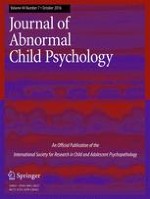23-12-2015
Family Processes in Child Anxiety: the Long-Term Impact of Fathers and Mothers
Gepubliceerd in: Research on Child and Adolescent Psychopathology | Uitgave 7/2016
Log in om toegang te krijgenAbstract
The current study investigated links between parent and child anxiety, and family process factors, over a 9 year period. Specifically, we examined the role of partner conflict, attachment security and parental autonomy granting in explaining changes in child, father, and mother anxiety symptoms. We utilized data from the NICHD Study of Early Child Care and Youth Development (N = 661), from when target children were in first grade (6 years), fifth grade (10 years), and 15 years of age. We tested a longitudinal path model including both fathers and mothers, and found that the model was a good fit for the data. We also found that lower attachment security to fathers and a restriction of maternal autonomy granting predicted which children maintained anxiety into adolescence. Partner conflict explained the association between earlier and later parental anxiety, which is a novel finding in the literature. Together, these findings suggest that fathers play an important long-term role in child anxiety, alongside the role of mothers.
